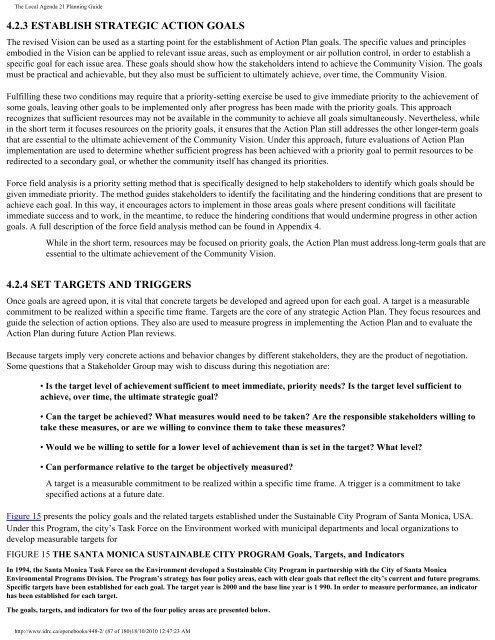The Local Agenda 21 Planning Guide - Democrats Against UN ...
The Local Agenda 21 Planning Guide - Democrats Against UN ...
The Local Agenda 21 Planning Guide - Democrats Against UN ...
You also want an ePaper? Increase the reach of your titles
YUMPU automatically turns print PDFs into web optimized ePapers that Google loves.
<strong>The</strong> <strong>Local</strong> <strong>Agenda</strong> <strong>21</strong> <strong>Planning</strong> <strong>Guide</strong><br />
4.2.3 ESTABLISH STRATEGIC ACTION GOALS<br />
<strong>The</strong> revised Vision can be used as a starting point for the establishment of Action Plan goals. <strong>The</strong> specific values and principles<br />
embodied in the Vision can be applied to relevant issue areas, such as employment or air pollution control, in order to establish a<br />
specific goal for each issue area. <strong>The</strong>se goals should show how the stakeholders intend to achieve the Community Vision. <strong>The</strong> goals<br />
must be practical and achievable, but they also must be sufficient to ultimately achieve, over time, the Community Vision.<br />
Fulfilling these two conditions may require that a priority-setting exercise be used to give immediate priority to the achievement of<br />
some goals, leaving other goals to be implemented only after progress has been made with the priority goals. This approach<br />
recognizes that sufficient resources may not be available in the community to achieve all goals simultaneously. Nevertheless, while<br />
in the short term it focuses resources on the priority goals, it ensures that the Action Plan still addresses the other longer-term goals<br />
that are essential to the ultimate achievement of the Community Vision. Under this approach, future evaluations of Action Plan<br />
implementation are used to determine whether sufficient progress has been achieved with a priority goal to permit resources to be<br />
redirected to a secondary goal, or whether the community itself has changed its priorities.<br />
Force field analysis is a priority setting method that is specifically designed to help stakeholders to identify which goals should be<br />
given immediate priority. <strong>The</strong> method guides stakeholders to identify the facilitating and the hindering conditions that are present to<br />
achieve each goal. In this way, it encourages actors to implement in those areas goals where present conditions will facilitate<br />
immediate success and to work, in the meantime, to reduce the hindering conditions that would undermine progress in other action<br />
goals. A full description of the force field analysis method can be found in Appendix 4.<br />
While in the short term, resources may be focused on priority goals, the Action Plan must address long-term goals that are<br />
essential to the ultimate achievement of the Community Vision.<br />
4.2.4 SET TARGETS AND TRIGGERS<br />
Once goals are agreed upon, it is vital that concrete targets be developed and agreed upon for each goal. A target is a measurable<br />
commitment to be realized within a specific time frame. Targets are the core of any strategic Action Plan. <strong>The</strong>y focus resources and<br />
guide the selection of action options. <strong>The</strong>y also are used to measure progress in implementing the Action Plan and to evaluate the<br />
Action Plan during future Action Plan reviews.<br />
Because targets imply very concrete actions and behavior changes by different stakeholders, they are the product of negotiation.<br />
Some questions that a Stakeholder Group may wish to discuss during this negotiation are:<br />
• Is the target level of achievement sufficient to meet immediate, priority needs? Is the target level sufficient to<br />
achieve, over time, the ultimate strategic goal?<br />
• Can the target be achieved? What measures would need to be taken? Are the responsible stakeholders willing to<br />
take these measures, or are we willing to convince them to take these measures?<br />
• Would we be willing to settle for a lower level of achievement than is set in the target? What level?<br />
• Can performance relative to the target be objectively measured?<br />
A target is a measurable commitment to be realized within a specific time frame. A trigger is a commitment to take<br />
specified actions at a future date.<br />
Figure 15 presents the policy goals and the related targets established under the Sustainable City Program of Santa Monica, USA.<br />
Under this Program, the city’s Task Force on the Environment worked with municipal departments and local organizations to<br />
develop measurable targets for<br />
FIGURE 15 THE SANTA MONICA SUSTAINABLE CITY PROGRAM Goals, Targets, and Indicators<br />
In 1994, the Santa Monica Task Force on the Environment developed a Sustainable City Program in partnership with the City of Santa Monica<br />
Environmental Programs Division. <strong>The</strong> Program’s strategy has four policy areas, each with clear goals that reflect the city’s current and future programs.<br />
Specific targets have been established for each goal. <strong>The</strong> target year is 2000 and the base line year is 1 990. In order to measure performance, an indicator<br />
has been established for each target.<br />
<strong>The</strong> goals, targets, and indicators for two of the four policy areas are presented below.<br />
http://www.idrc.ca/openebooks/448-2/ (87 of 180)18/10/2010 12:47:23 AM










